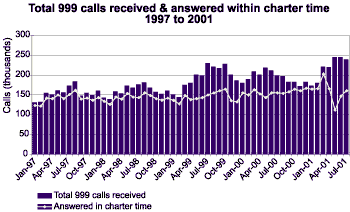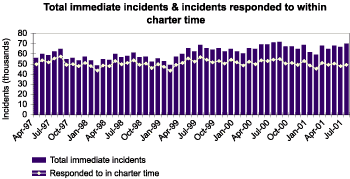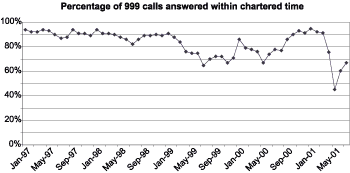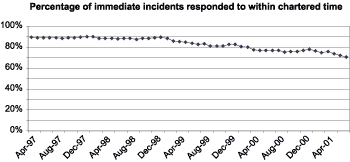Contents
Report 5 of the 11 Oct 01 meeting of the Professional Standards and Performance Monitoring Committee and provides an update on the performance of the MPS in answering and responding to 999 calls.
Warning: This is archived material and may be out of date. The Metropolitan Police Authority has been replaced by the Mayor's Office for Policing and Crime (MOPC).
See the MOPC website for further information.
Demand and response
Report: 5
Date: 11 October 2001
By: Commissioner
Summary
This report provides an update on the performance of the MPS in answering and responding to 999 calls. The report outlines levels of demand and describes initiatives to manage demand and improve performance.
A. Recommendations
That Committee support the initiatives being put in place to manage the demand and improve the performance.
B. Supporting information
Introduction
1. Emergency response is an MPS sustained activity for service delivery in 2001/02, with the following targets:
- To answer 80% of emergency 999 calls within 15 seconds
- To respond to 80% of urgent incidents within 12 minutes
- To obtain 90% public satisfaction with police action in response to 999 calls.
Demand
2. The problem faced by the MPS achieving these targets is the continuous growth in demand made on the emergency services. The chart below displays the total number of 999 calls offered between 1997 and 2001 and the number of these calls that were responded to within the charter time. For percentage target achievement see Appendix 1.

3. There has been a steady increase in demand made on the MPS emergency services over the last five years. The significant peak appeared in July 1999 (although the growth to this peak began in April). The following must however be taken into account when comparing recent trends to those prior to 1998. December 1998 recorded the highest level of sales of new mobile phones in the UK and it is evident that this has had a significant factor in increased 999 calls during 1999, both genuine and inadvertent (silent) calls.
4. Comparing the beginning (April-July) of each of these five financial years, the biggest increase was recorded in 1999, which recorded a 21% increase from the previous period. Although the following year continued this upward trend, there were clear signs of demand slowing down, with 2000/01 recording a smaller increase of 2.5%. In the beginning of 2001/02 a 14% increase from the preceding year was recorded, which is still a smaller increase than in 1999, but there is an inference that if the MPS do not take any action a further increase will occur.
5. The daily average of 999 calls offered to the MPS between April and June 1999/00 was 6,734, in 2000/01 it rose to 6,907, whilst in the same period 2001/02 it has increased significantly to 7,892. The performance of the MPS is reflected in this trend, where between April to June 1999/00 70% of calls were answered in time, but as the demand slowed down in 2000, performance rose to 73%. Then again when demand increased in 2001 performance fell to 62%.
6. It is evident from the chart above that there is a very distinctive seasonal trend in January and February in each of these five years. There is on average a drop of between 10,000-20,000 calls from the previous October/December months and following this a rapid increase in the subsequent months of March and April. The most significant increases following these seasonal falls were displayed in 1999 (21%) and 2001 (27%).
Reasons for fluctuating demand
7. The main reason for the increase in 999 calls in both 1999 and in 2001 is the increasing volume of silent mobile calls. Consequently the reason why demand decreased and performance increased in 2000 was because of a new protocol for dealing with silent calls introduced formally in August 2000, but which was in place for four days at the end of December 1999.
8. A filtering criteria for emergency calls was introduced to the phone operators, whereby mobile calls would only be passed to the police if a voice was heard, ‘silent’ calls would not. This system did initially significantly reduced the demand made on the MPS emergency services between December and January 1999/00.
9. The trends in demand fluctuated considerably throughout the year, falling abruptly in May 2000 and continuing with this downward trend for 7-8 months, until again demand began increasing.
10. The cause of this variance was identified by the MPS a lot later on in June 2001 when it was discovered that the use of the filtering criteria had been subjected to a number of changes. The MPS criteria demanded that any calls where a voice can be heard should be passed to the police. Initially this criteria was being adhered to, but in May 2000 when the system was implemented as a national permanent policy it appears that the more experienced operators were consciously ignoring it. The operators with the best intentions were not passing calls, which they judged to be silent, for example where a station announcer or other background noise could be heard. BT managers on identifying this deviation from the criteria, began in May to enforce the policy more strictly. This was assisted by the fact that they closed a number of large exchanges and opened several smaller ones with newly trained staff who rigidly followed the criteria. As a consequence silent mobile calls with background noise returned to the MPS.
11. It is only now that the MPS has begun to experience the true impact of the new protocol. Although these inadvertent mobile calls are being filtered, the MPS is now again receiving every silent mobile call where background voices can be heard and these calls remain a substantial and increasing number.
12. In recognition of this problem an urgent meeting was scheduled between the MPS and BT where a suggested solution, which has been found to work technically (the MPS received between 1300 to 2000 silent calls a day with no administrative or operational problems) was authorised. The scheme was originally a solution to the MPS problem, but has since been seen as an opportunity to pilot a procedure that could potentially be used nationally. The MPS is the only UK service with the capacity for the nation given the scale of its switch technology.
13. The scheme was agreed with BT, Cable and Wireless and the Home Office 999 liaison committee and Hampshire Constabulary led the project on behalf of ACPO. The scheme was implemented on the 1 October 2001 and statistics have found it to be very successful.
14. Originally the silent calls were going to be passed to the MPS using a separate number on one of our Automatic Call Distribution (ACD) systems. If a caller could not be identified on the line it would be terminated, but if a caller was identified the call would be re-routed into the police information room on a higher priority line. This scheme was estimated at a cost of £250,000, which would have required a contribution from all the participating forces.
15. The MPS Communication Department have however, successfully re-configured this system to be more cost effective. Adapting the existing IT and utilising the current emergency line capacity the MPS have been able to develop a system, which can facilitate the silent mobile scheme on a national level. This can be implemented and run without incurring any cost to itself or any other provincial force. On receiving a silent mobile call, the caller will be played an automated recording, asking them to depress the ‘5’ key twice. If the key is depressed a second recording will announce to the caller and advise the operator that this call should be routed to the relevant constabulary information room. If the key is not depressed the line will be terminated by the operator.
16. On the 1 October 2001, the system recorded 10,398 silent mobile calls and 17 of these were forwarded to the relevant police operators after the ‘5’ key was depressed (twice). Of these 17 calls none proved to be genuine.
17. The projected efficiency savings for the MPS by this new automated system has been costed at £1,450 a day and £53,000 for a full year. The participating forces will no longer be required to contribute to this scheme, however it has been requested through ACPO that these forces volunteer a contribution, which will be paid into a research fund. The fund will be used to test and develop other systems that could relieve the emergency services. For example a system for silent land lines or kiosks.
18. The MPS also want to send a text message to these mobiles, as an automatic response to silent activation, but BT will only assist if the wording is educational rather than confrontational and discussions are taking place to agree the wording. The costs of this are being investigated since there will be a large volume of messages and high costs unless BT sponsor the scheme. For both of these projects the MPS will be spreading the costs, project responsibility and the risk management amongst the other national forces.
19. Both of these initiatives are active examples of 'joined up government' and part of the electrical government initiative. The MPS can demonstrate efficiency savings from making the process electronic
20. Once this system is operational however, it will be impossible to assess how many of the silent calls received are from the MPS and how many are received on behalf of other national forces. The number of silent calls will therefore be removed from the statistics, which reflect the demand made on the MPS emergency services. It must however be taken into account that although there will be a reduction in silent mobile calls put through to primary 999 operators, the demand will be balanced by the receipt of calls previously diverted direct to boroughs. Consequently police operators and officers will still be working to similar demand levels and performance will not necessarily display a significant improvement. However, it will benefit the MPS, by relieving the pressure placed on the boroughs call receipt and deployment centres, which are currently handling a significant number of 999 calls. It will also better facilitate genuine callers getting through to an experienced emergency call operator and it should also lead to improvements in customer satisfaction levels.
C3i 999 call handling centralisation
21. The C3I project team, although not involved in the development and implementation of this silent mobile system, were aware of the proposals and have since been advised of its success. The new centralised 999 system being developed by C3I is not expected to be operational until 2004, however it is anticipated that this new established system will be integrated into the final 999 call handling structure.
Response performance
22. The MPS target is to arrive at urgent incidents within 12 minutes 80% of the time. The chart below displays the gradual increase in urgent incidents recorded by the MPS over the last five years, which has had an impact on the MPS’s performance in responding to 999 calls within charter time

23. In 2000/01 there were a total of 80,3626 urgent incidents reported to the MPS. Of these 76.4% were dealt with within charter time, just below the corporate target. Between April and July 2001, 73% of the urgent incidents have been responded to within time, which is a reduction of 5% from the same period last year.
Customer satisfaction
24. There is a target for the MPS to achieve 90% customer satisfaction in relation to police action in response to 999 calls. The method of assessment was changed significantly in April 2000 and it is difficult to compare current figures with those reported previously. The previous financial year recorded an overall satisfaction rate of 79%, but the last two quarters did however record an improvement around 81%. The first quarter of 2001/02 has recorded a satisfaction rate of 78%, which is consistent with the rate achieved in the same quarter previously.
Conclusion
25. This report has outlined the growing demands faced by the MPS emergency services and highlighted the methods by which the MPS has sought to meet this demand and improve performance. There have been a variety of variables explored in the report that may have had a direct effect on these figures and performance levels in recent years.
C. Financial implications
The activity outlined in this paper is accounted for within the existing budget.
D. Background papers
None.
E. Contact details
Author: Karen Turner, MPS Corporate Performance Analysis Unit
For information contact:
MPA general: 020 7202 0202
Media enquiries: 020 7202 0217/18
Send an e-mail linking to this page
Feedback

